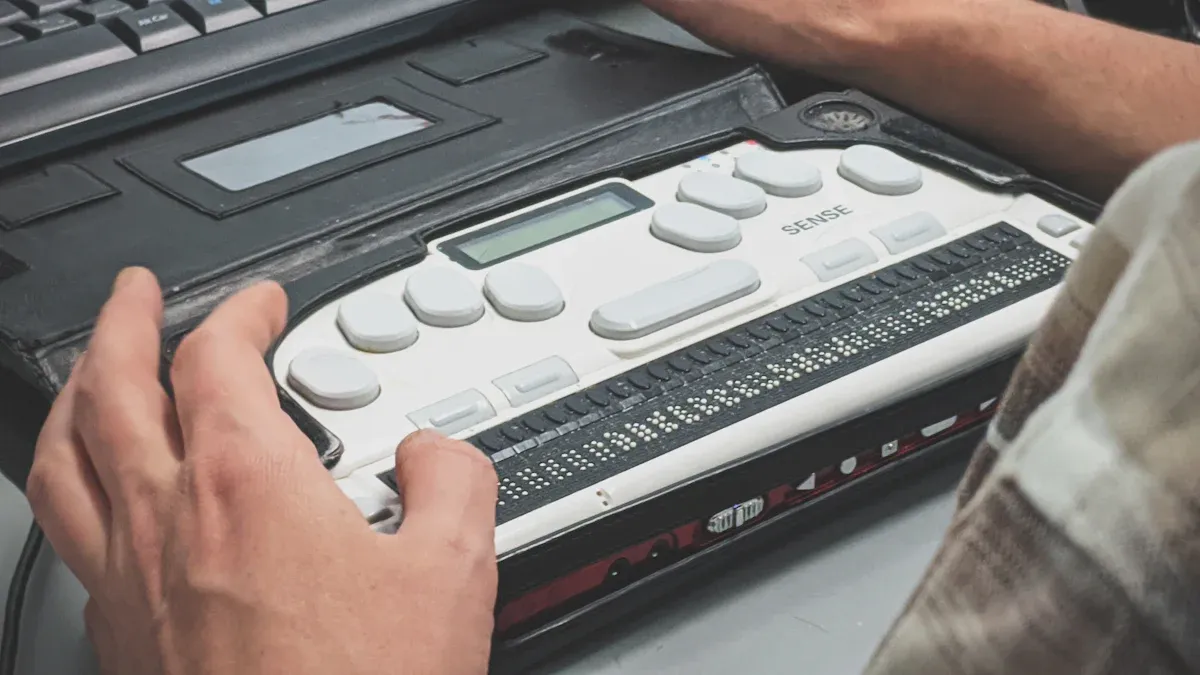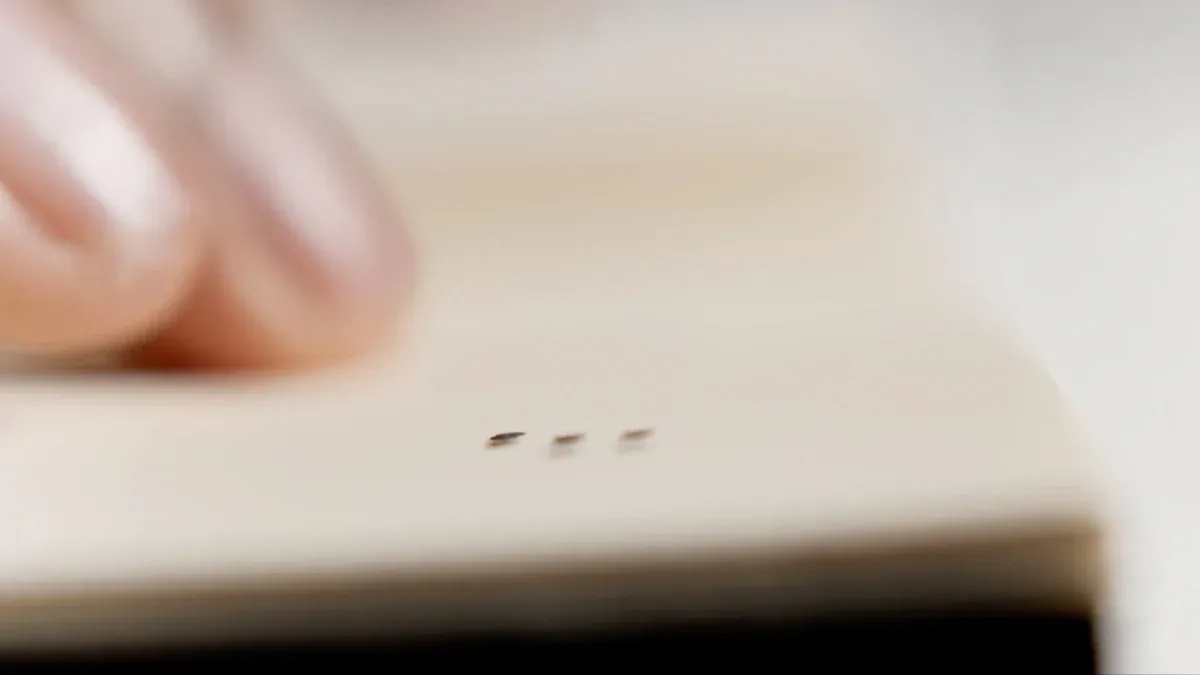
Access to technology can transform how you interact with the world, especially if you are visually impaired. A Braille keypad or digital keypad with tactile feedback ensures accurate typing and reduces frustration. Without these tools, locating keys becomes challenging, and typing slows down. Devices like an industrial braille keypad or illuminated keypad also improve comfort and efficiency, empowering you to work independently.
Key Takeaways
- Braille keypads help blind users by giving touchable feedback. This lets them type correctly without needing to see.
- Picking the best Braille device means thinking about what you need. Look at things like size, cost, and features like wireless use.
- A Braille keypad helps users work alone and get more done. They can write or browse without asking for help.
Why Braille Keypads and Keyboards Matter
Enhancing Accessibility for Visually Impaired Users
Braille keypads play a crucial role in making technology accessible to visually impaired users. These devices replace standard keys with embossed Braille symbols, allowing you to identify keys through touch. This tactile feedback ensures accurate typing and helps you navigate digital content independently.
Using a braille keypad, you can confidently type without relying on visual assistance. Many models also support direct Braille input, which improves typing precision. Ergonomic designs further enhance comfort, especially during extended use. These features make it easier for you to participate in activities like writing emails, browsing the web, or completing assignments.
Promoting Independence and Productivity
A braille keypad empowers you to perform tasks independently. Whether you’re a student, professional, or someone managing daily activities, these devices help you stay productive. They eliminate the need for constant assistance, giving you the freedom to work at your own pace.
For example, you can use a Braille keyboard to write reports, communicate with others, or even program software. This independence boosts your confidence and allows you to focus on achieving your goals. By promoting self-reliance, these tools open up new opportunities for personal and professional growth.
Key Features to Look for in Braille Devices
When choosing a Braille device, consider your specific needs. If you plan to use it frequently, look for a model designed for heavy workloads. Portable devices are ideal if you need something compact, while larger models suit stationary use.
Budget is another important factor. Braille devices vary in price, so find one that fits your financial situation. Some models offer additional features like Braille translation or wireless connectivity, which can enhance usability. Lastly, ensure the device supports the level of Braille complexity you require, whether it’s basic or advanced.
By evaluating these features, you can select a Braille keypad that aligns with your lifestyle and preferences.
Top 10 Braille Keypads and Keyboards

BrailleSense 6
The BrailleSense 6 is a powerful device designed for users who need advanced functionality. It combines a Braille display with a built-in notetaker, allowing you to create and edit documents without needing a separate computer. Its Android-based operating system supports a wide range of apps, making it versatile for both personal and professional use. The device also includes features like GPS navigation and media playback, enhancing its usability. If you want a device that offers more than just typing, this could be an excellent choice.
Mantis Q40
The Mantis Q40 stands out with its unique combination of a QWERTY keyboard and a 40-cell refreshable Braille display. This design makes it ideal if you’re already familiar with standard keyboards.
- Internal applications let you manage files, edit documents, and read books.
- You can connect up to five Bluetooth devices and one USB device simultaneously.
- Battery life ranges from 12 to 17 hours, depending on usage.
- The device supports direct downloads from Bookshare and NFB Newsline.
This versatility ensures you can stay productive whether you’re at home or on the go.
Hable One
The Hable One is a compact and portable braille keypad designed for smartphones and tablets. Its ergonomic design makes it easy to hold and use, even for extended periods. You can control your device entirely through this keypad, from typing messages to navigating apps. Its small size makes it perfect if you need a lightweight option for travel or daily use.
Brailliant BI 40X
The Brailliant BI 40X offers a robust set of features for users who need a reliable Braille display. Here’s a quick overview of its specifications:
| Specification | Detail |
|---|---|
| Braille Cells | 40 |
| Keyboard | Standard Perkins-style |
| Internal Memory | 32 GB |
| 연결성 | USB-A port, Bluetooth 5 |
| Dimensions | 12.01" x 3.54" x 0.86" |
| Weight | 1.59 lbs |
| Construction | Durable plastic |
This device also includes onboard applications powered by KeySoft Lite, supports multiple file types, and offers a secure exam mode. Its ergonomic design ensures comfort during long hours of use.
Sensory-Keys Braille and Large-Print Keyboard
The Sensory-Keys keyboard combines Braille and large-print labels, making it suitable for users with varying levels of visual impairment. Its high-contrast keys improve visibility, while the tactile Braille markings ensure accessibility. This keyboard is an excellent choice if you share your workspace with others who may not use Braille.
Logickeyboard Braille Keyboard
The Logickeyboard Braille Keyboard is designed for simplicity and efficiency. It features tactile Braille markings on each key, allowing you to type accurately without visual assistance. Its plug-and-play functionality ensures compatibility with most computers, making it a hassle-free option for everyday use.
Juliet 120 Braille Embosser
The Juliet 120 Braille Embosser is perfect if you need to produce high-quality Braille documents. It offers:
- Printing speeds of up to 140 characters per second.
- Double-sided and interpoint Braille support.
- Adjustable Braille dot height for personalized reading preferences.
- Tactile graphics printing at 50 dpi.
This embosser integrates seamlessly with various devices and includes software for creating tactile graphics. It’s ideal for educational, business, or personal use.
Adaptive Keyboards by MaxiAids
Adaptive Keyboards by MaxiAids provide a wide range of customization options to suit your needs. These include:
- Large Print and Braille Key Labels.
- Ergonomic Keyboard Holders.
- Illuminated and Dvorak Style Keyboards.
- Adaptive software for Mac and Windows.
These options ensure you can find a solution tailored to your specific requirements.
Large Print and Braille Keyboard Labels
If you already own a keyboard, adding large print and Braille labels can enhance its accessibility. These labels are easy to apply and provide a cost-effective way to make your existing device more user-friendly.
Additional Braille Keypads and Accessories
Many additional accessories can complement your Braille keypad. For example, ergonomic wrist rests can improve comfort during long typing sessions. Portable Braille displays can connect to your smartphone or tablet, offering flexibility and convenience. Explore these options to enhance your overall experience.
Comparison Table of Top 10 Braille Keypads and Keyboards

Key Features Compared
Each Braille device offers unique features tailored to different needs. Here’s a quick comparison:
- Hable One: Compact and portable, designed for handheld use. Its roller keys make navigation intuitive.
- Orbit Writer: Requires a flat surface for use. It includes an arrow pad for precise control.
- Perkins Smart Brailler: Lighter than the classic version. It allows you to save documents but lacks portability.
- Harpo BraillePen Slim: Extremely portable with Bluetooth connectivity. However, its small size increases the risk of misplacement.
User feedback highlights the Hable One for its high satisfaction ratings. The Orbit Writer receives mixed reviews due to update limitations, while the Harpo BraillePen Slim is praised for portability but criticized for shorter battery life.
Pricing Overview
Braille devices vary significantly in price. Here’s a snapshot of the price ranges:
| Product Name | Price Range |
|---|---|
| Nero Slimline 6 Dot Braille Keyboard – PC | $299.00 |
| Wireless Braille Keyboard by Logickeyboard | Starting at $346.47 |
| Braille Keyboard for the Blind – PC Nero Slim Line | Starting at $356.00 |
These prices reflect the diversity in features and build quality. Consider your budget and the features you need before making a decision.
Compatibility and Usability
Many Braille devices are compatible with both Windows and macOS systems, ensuring flexibility. Some examples include:
- BraillePen (Bluetooth)
- BrailleConnect 24 (USB, Bluetooth)
- BrailleNote Touch 32 (Bluetooth)
- Orbit Reader 20 (USB, Bluetooth)
- Braille Sense Plus (USB, Bluetooth)
These devices also support various connectivity options, making them versatile for different setups. If you use multiple devices, prioritize models with both USB and Bluetooth compatibility for seamless integration.
Choosing the right Braille device can transform your daily life.
- Standout Features:
- Desktop displays (80 cells) enhance productivity for complex tasks.
- Notetakers combine Braille displays with tools like calendars and media players.
- Compact designs and long battery life suit users on the go.
These devices improve accessibility by enabling independent reading, writing, and navigation. Evaluate your needs, such as portability, compatibility, and budget, to find the perfect match.
제품 정보
What is the difference between a Braille keyboard and a Braille display?
A Braille keyboard allows you to input text using Braille. A Braille display converts on-screen text into tactile Braille, enabling you to read digital content.
Are Braille keyboards compatible with smartphones?
Yes, many Braille keyboards, like the Hable One, connect to smartphones via Bluetooth. This feature lets you type and navigate apps seamlessly.
How do I choose the right Braille device for my needs?
Tip:
Consider your usage frequency, portability needs, budget, and required features like wireless connectivity or advanced Braille translation. Match these factors to your daily activities.


